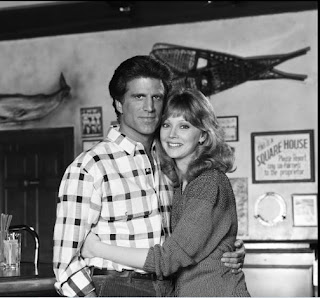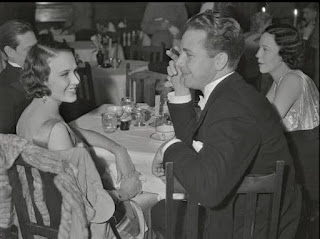"She's skinny; she's a little bowlegged; she can't sing much. She's certainly no raving beauty, and she's got a speaking voice that seems to be crying for cough drops after every syllable." That's how one plain-speaking insider described June Allyson, who, for filmgoers since the 1940s, was always been the wistful girl next door, wearing Peter Pan collars and starched skirts. It was an image which fit neatly into the "family" of MGM stars. She fortuitously began in motion pictures in the middle of America's involvement in World War II, a time when the public held high in esteem the wholesome girlfriend or wife left behind by a soldier going to war. June projected this wholesomeness very convincingly and the public eagerly went to see her films.
As a teenager, June entered Amateur Night dance contests in the Bronx, and even though she never won, she kept on dancing. Things were a little better at home, now an apartment at 1975 Bryant Avenue, since her mother had remarried. After high school June began to seek jobs as a dancer. There was a $50 a week play date at the Club Lido in Montreal and then appearances in several movie shorts for Vitaphone and Educational Films. When June was twenty, she got a part in the chorus line of a Broadway musical Sing Out The News. When that flopped, she joined the chorus line of the Copacabana nightclub until she was hired for the chorus of Jerome Kern–Oscar Hammerstein II's musical Very Warm For May. That show opened in 1939, and one of her colleagues in the chorus was Vera-Ellen. This role got June into Rodgers and Hart's Higher And Higher. She recalls: "I've been in more flops than you can imagine. It was Richard Rodgers who was always keeping them from firing me, as every dance director wanted to do."
According to June, it was MGM producer Joe Pasternak who persuaded Louis B. Mayer to look at her screen test by pleading to the studio kingpin: "Please look at this test and do just two things. Look at her eyes and listen to her voice. Don't pay any attention to anything else about her. These are distractions we can iron out." Thus was born the celluloid June Allyson, the diminutive blonde/redhead with the surprisingly husky voice (caused by chronic bronchitis and enlarged vocal cords—in 1961 she underwent a throat operation).
The Stratton Story (1949) was a very good biopic starring James Stewart as the baseball player who loses his leg in a hunting accident. June's husband Dick Powell had persuaded her to accept the assignment as the typical wife-next-door, because he was perceptive enough to know she had far more competition in glamorous musical roles. The Stratton Story displays her beautifully in her screen synthesis as an unsophisticated Margaret Sullavan type of screen star. The final straw for June was when the promised role in The Long, Long Trailer (1954) was handed to ex-MGM player Lucille Ball. However, June went into the top-grossing The Glenn Miller Story (1954) at Universal at the special request of James Stewart.
Dick Powell, who played Napoleon Bonaparte's younger brother who woos Dixie American Marion Davies in the costume musical Hearts Divided (1936), would recount his experiences on the set to Tony Thomas. Powell recalled that William R Hearst would not allow Marion to perform unless he was on the set. Usually the mogul would be accompanied by three bulky associates, who said nothing but looked about with great intentness. "Those love scenes," Powell remembered, "were sheer torture. If I didn't make them look real, the director [Frank Borzage] would never use me again. If I made them too real, I was sure I was going to get a bullet in the back. Marion was doing her part in the long kissing closeups, but I was damn near choking to death. That picture lasted ten weeks, and I thought I'd die before I got out. I was still shaking months afterwards." By 1937 Hearst's empire was beginning to crumble and Marion at age forty retired from the cinema.
Her last performance was in a dramatization of The Brat on Lux Radio Theatre in July 1936. On September 22, 1961, Marion died at age sixty-four, leaving an estate of eight million dollars. Perhaps Mary Astor, who worked with Marion in Warner Brothers' Page Miss Glory (1935), summed up the off-screen Marion best: "She was not hard and inquisitive, nor was she a dumb blonde. She was bright and funny. Her warmth and kindness could have taught many of us a great deal about the art of loving." That definition of Marion definitely might cast doubt about her veiled depiction in Center Door Fancy (written by Dick Powell's ex-wife Joan Blondell) as a vengeful shady character. Yet, the worst character portrayed by Blondell is Amy O'Brien (inspired by June Allyson) that maybe reflects more on Blondell's troubled mind than Allyson's alleged "naughtiness."
If it were not bad enough that the June Allyson faction at MGM was burying Gloria's film career for good, she up and retired for two years when she wed actor John Payne. However, she looked back on the studio system with fondness: "You lived there, you worked there, you grew up there. You knew everyone around you. We were groomed, step by step, for stardom. Nobody was thrown into something before they were ready for it. And I miss the movies that were made for the sheer entertainment of the audience." Divorced in 1969 from her third husband Richard Fincher (who later became a Florida state senator), in 1971, at the persuasion of her good friend June Allyson, Gloria DeHaven moved back to California. She said of her old glamour MGM years: "I didn't begin to grow up until I was forty; and now I can face reality, but escaping from it via 'sheer entertainment' can be fun."
Bottle-blonde bombshell of 1940s and 1950s "B" films, Adele Jergens (who dated Ronald Reagan) typically played hardcore floozies and burlesque dancers. In the early 1940s, she worked as a Rockette, and was named the Number One Showgirl in New York City. She got her first break understudying Gypsy Rose Lee as a burlesque strip artist in the Broadway show "Star and Garter" in 1942. Lee fell ill for two weeks during the show's run. A talent scout for Columbia Pictures caught Jergens's performance and signed her to a contract. A year later, in 1943, Joan Blondell had displaced Gypsy Rose Lee as Mike Todd's girlfriend. It was hard on Lee, as Jergens (who played Marilyn Monroe's mother in Ladies of the Chorus) and others observed. Conveniently, Blondell ignored Lee largely in her confessional tome.
In 1954, June Allyson said: "We all seem to have an instinct to blame someone or something for personal tragedy." Was she possibly alluding to Blondell's stubborn accusations and exaggerations towards her? During Allyson and Powell marriage crisis in 1957, Beverly Ott reported that Powell sighed: "Sometimes it seems all the love in the world is not enough for June." Although Powell was thought of as a powerful mogul in Hollywood, at the time of his death, his estate was estimated to be worth 2 million. The divorce of June Allyson from Glenn Maxwell was prompted by the terms of Powell's will: She would receive $4,000 monthly if she stayed unmarried. Allyson was quoted as saying that Maxwell was "the nicest man I've ever known—besides Richard."
Sources: The MGM Stock Company: The Golden Era (2015) by James Robert Parish and The Dick Powell Story (1992) by Tony Thomas





.jpg)

.jpg)



.jpeg)












.webp)



















.jpg)




















